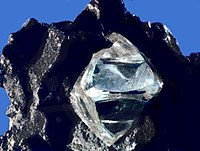
Photo from wikipedia
Abstract Purpose The PTW microDiamond has an enhanced spatial resolution when operated in an edge‐on orientation but is not typically utilized in this orientation due to the specifications of the… Click to show full abstract
Abstract Purpose The PTW microDiamond has an enhanced spatial resolution when operated in an edge‐on orientation but is not typically utilized in this orientation due to the specifications of the IAEA TRS‐483 code of practice for small field dosimetry. In this work the suitability of an edge‐on orientation and advantages over the recommended face‐on orientation will be presented. Methods The PTW microDiamond in both orientations was compared on a Varian TrueBeam linac for: machine output factor (OF), percentage depth dose (PDD), and beam profile measurements from 10 × 10 cm2 to a 0.5 × 0.5 cm2 field size for 6X and 6FFF beam energies in a water tank. A quantification of the stem effect was performed in edge‐on orientation along with tissue to phantom ratio (TPR) measurements. An extensive angular dependence study for the two orientations was also undertaken within two custom PMMA plastic cylindrical phantoms. Results The OF of the PTW microDiamond in both orientations agrees within 1% down to the 2 × 2 cm2 field size. The edge‐on orientation overresponds in the build‐up region but provides improved penumbra and has a maximum observed stem effect of 1%. In the edge‐on orientation there is an angular independent response with a maximum of 2% variation down to a 2 × 2 cm2 field. The PTW microDiamond in edge‐on orientation for TPR measurements agreed to the CC01 ionization chamber within 1% for all field sizes. Conclusions The microDiamond was shown to be suitable for small field dosimetry when operated in edge‐on orientation. When edge‐on, a significantly reduced angular dependence is observed with no significant stem effect, making it a more versatile QA instrument for rotational delivery techniques.
Journal Title: Journal of Applied Clinical Medical Physics
Year Published: 2020
Link to full text (if available)
Share on Social Media: Sign Up to like & get
recommendations!